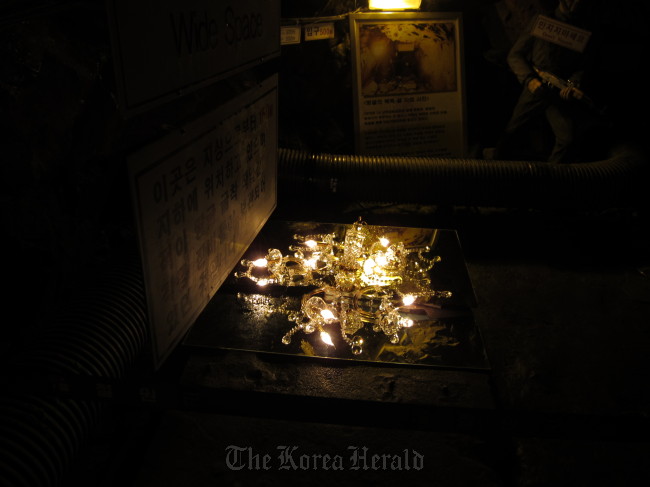Works on display at tour sites of Cheorwon Security Tour show realities of a divided peninsula
Security is of utmost importance at the heavily fortified 250-kilometer-long Demilitarized Zone along the 38th parallel that divides the Korean Peninsula into South and North Korea. And though Cheorwon Peace Observatory boasts a panoramic view of North Korea, well into the propaganda village close to the border, tourists are often prohibited from taking photos for security reasons.
On the third floor of the observatory, however, visitors can find a photo by Suntag Noh, a photographer participating in the ongoing Real DMZ Project 2012, right in front of the warning post that says “no photo shoots allowed.”
Noh’s photo, part of a photography collection titled “To Survive vs. Once Arrived,” shows a South Korean soldier gazing at the border of the two Koreas and the warning post. “Is it illegal if I took a photo of a warning sign that says ‘no photo shoots allowed’?” Noh said during a press tour of the exhibition last week.
 |
“To Survive vs. Once Arrived” by Suntag Noh is posted on the wall of a look-out spot at Cheorwon Peace Observatory. (Samuso) |
Noh’s ironic take on the warning sign adds humor to the somewhat rigid atmosphere of the building. “The soldier in the picture might be like a visitor himself, gazing at the South-North borderline. Through my picture, I wanted to capture people’s desire through the act of gazing,” Noh said.
Noh defined his photo works as an “intervention” of the touring experience. Like the 38-year-old photographer, the 11 participating artists of Real DMZ Project 2012 show site-specific art works that interact with five tour sites of the Cheorwon Security Tour.
Woljeong-ri Station, an abandoned train station where a train used to run between South and North Korea, has been turned into an art exhibition space for works by Sylbee Kim, Simon Morley and Suntag Noh. Sylbee Kim, a 31-year-old Korean artist who works in both Berlin and Seoul, screens “Friendly Fire” at the site. The short film symbolically portrays the relationship between the two Koreas as a homosexual incestuous relationship between twin brothers.
“The film illustrates a world beyond reach, a journey unfinished,” explained Kim.
North Koreans dug the Second Underground Tunnel to be used for infiltrating South Korea in a surprise attack, but was discovered by a South Korean soldier in the 1970s. It is 3,500 meters long and 2 meters tall, big enough for an average man to walk through. Some 1,100 meters of the tunnel is dug into South Korean land and visitors are allowed to walk only 500 meters north. After walking 500 meters of the narrow, bumpy tunnel, visitors find a dismantled yet brightly lit chandelier that shines on a mirror panel.
 |
“Mycheongjuchandelierchohab-Chandelier 363-931” by Dirk Fleischmann at the Second Underground Tunnel. (Samuso) |
Dirk Fleischmann, art professor of Cheongju University presented “mycheongjuchandelierchohab-Chandelier 363-931” with Shin Hyo-chul, his master’s program student.
“After walking in fear and anxiety that the tunnel induces, the chandelier will confuse the audience with its glamor,” said Fleischmann.
“I do not mean to compete with (the experience of walking through) the tunnel, though.”
The insertions of various art pieces in DMZ function both as a reminder and a distraction of the tour experience.
“The chandelier is meant to provide a space and time for a little rest after all the walking,” Shin explained.
Other works presented include Lyang Kim’s “My Saintly Shelter” in front of the Labor Party Building, Jooyoung Lee’s “Waiting Together 10 li from DMZ” at the Monorail Station site, and Nicolas Pelzer’s “Dislocated Cinema” at the Cheorwon Peace Observatory.
Real DMZ Project 2012 takes place along the tour sites of Cheorwon Security Tour around the demilitarized zone from July 28 to Sept. 16. Individual tourists must provide ID, while group tourists traveling through Samuso do not.
Reservations can be made at www.realdmz.org. Call (070) 8233 5335 for information.
By Jennifer Ryu, Intern reporter (
ryu_jenn@hotmail.com)









![[Today’s K-pop] Blackpink’s Jennie, Lisa invited to Coachella as solo acts](http://res.heraldm.com/phpwas/restmb_idxmake.php?idx=644&simg=/content/image/2024/11/21/20241121050099_0.jpg)